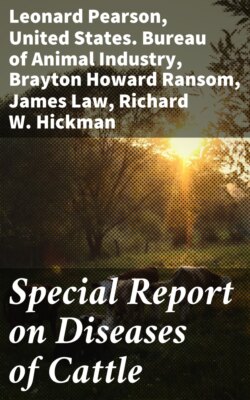Читать книгу Special Report on Diseases of Cattle - Lowe - Страница 141
На сайте Литреса книга снята с продажи.
VERMINOUS BRONCHITIS.
ОглавлениеThis is a disease that sometimes attacks young cattle when pastured in low-lying meadows near rivers subject to flood. It is caused by a small worm, Strongylus micrurus, which lodges in large numbers in the trachea and bronchial tubes, giving rise to considerable irritation of the air passages and inflammation. Sometimes the strongyles lodge in large numbers in the windpipe, forming themselves into a ball, and thus choke the animal to death.
Symptoms.—It is liable to attack a number of animals at once, and the weakest are the first to give way. The animal has a remarkably forcible cough, distressing, and of a special hacking and paroxysmal character. A stringy mucus is sometimes expelled during the spells of coughing. This mucus contains the Strongylus micrurus, which can be detected, or their ova observed, under a low power of the microscope. The attack has a subacute character and is very exhausting. The parasites, by becoming entwined in balls, seriously impede respiration, which is always remarkably labored in this disease.
Treatment.—The affected calves should be placed in a dry stable, protected from dampness, and subjected to fumigations of sulphurous anhydrid or chlorin gas. The liberation of chlorin gas is brought about by the action of sulphuric acid, either on a mixture of chlorid of sodium and black oxid of manganese or on bleaching powder. Sulphurous anhydrid may be procured by burning sulphur. Some practitioners prescribe small doses of spirits of turpentine in linseed oil. The system requires good support, and the diet should therefore be liberal and nutritious. Equal parts of sulphate of iron, gentian, and ginger make an excellent tonic.
Prevention.—Avoid pastures notorious for generating verminous bronchitis.
